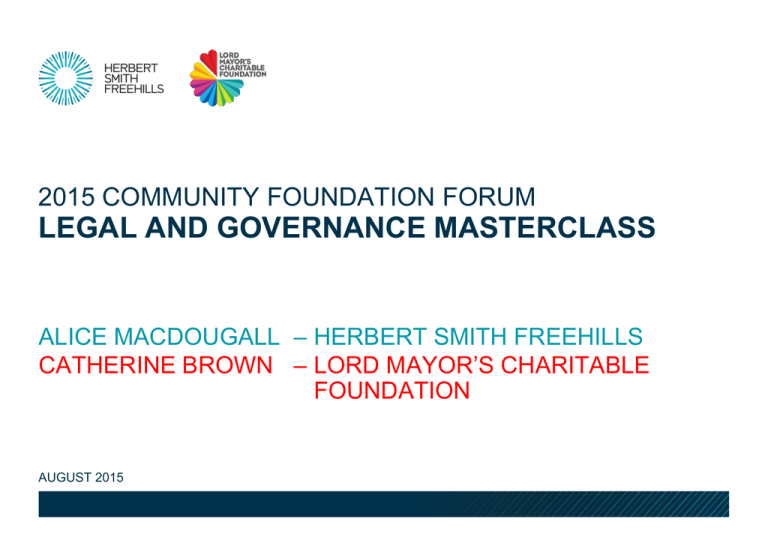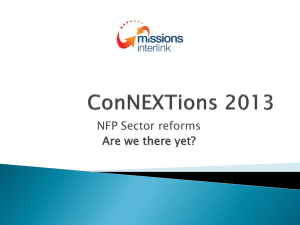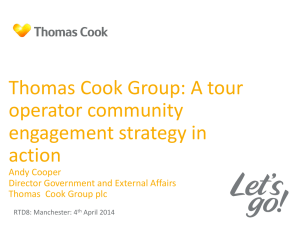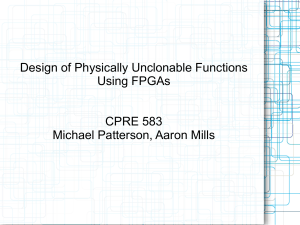2015 Governance & Legal community foundation forum
advertisement

2015 COMMUNITY FOUNDATION FORUM LEGAL AND GOVERNANCE MASTERCLASS ALICE MACDOUGALL – HERBERT SMITH FREEHILLS CATHERINE BROWN – LORD MAYOR’S CHARITABLE FOUNDATION AUGUST 2015 REVIEW, REFRESHER AND SOME NEW BITS! • • • • • • • • Is your legal structure working for you? Fundraising compliance Grantmaking compliance Is your administration working? Compliance checklist The role of the Board Is your Board working for you? Board success and induction 2 STRUCTURES Why is it so complicated? Company or Incorporated Association (Charitable Entity) Public Ancillary Trust (PuF) (DGR trust) Company or Incorporated Association (Charitable Entity) Charitable Trust (NOT DGR ) Public Ancillary Trust (PuF) (DGR trust) 3 Tax concession status affects what you can do Tax Concession Charity (TCC) • Must have purposes and activities in Australia which are charitable within the legal meaning • Entitled to exemption on income tax, FBT rebate, refund on imputation credits and under legislation of some States, payroll tax and stamp duties Deductible Gift Recipient (DGR) • Must meet criteria of one (and one only) of the categories listed in (Division 30 of the Income Tax Assessment Act 1997)- sample of categories below - complete list at www.ATO.gov.au/nonprofit/ • Able to receive tax deductible donations • Item 2 funds can only give to items 1 DGRC Item 1 Doing DRGs Item 2 Grant Making Public Benevolent Institution (PBI) • School building funds, library funds and scholarship funds • Universities and approved research institutes Public Ancillary Funds #CommunityLeadership Necessitous circumstances funds (emerg. relief) Cultural Organisations (on register of cultural organisations) Environment Organisations (on register of environmental organisations) Public Libraries, Museums and art galleries Overseas aid funds Prevention Health and control promotion of harm and charities abusive (prevention behaviour and control among of diseases humans in humans) Specifically listed / named organisations (eg RSPCA, Amnesty International, FRRR) Private Ancillary Fund 4 COMPLIANCE ISSUES Two entities with different tax status requires strict compliance requirements: • grant making o charitable purposes from the charitable entity o charitable item 1 DGRs from the PUF • fund raising o donor can’t direct o tax deductibility only for donations to the PUF • Board – majority of responsible persons for the PUF • Reporting – both separately to the ACNC, PUF to the ATO as well • Audit (or review) for the PUF 5 STRUCTURING OPTIONS • using FRRR more – instead of or together with public ancillary fund • using third party ancillary fund • PBI – using the Hunger Project case • possibility for change - PMCBP 6 GRANT MAKING COMPLIANCE – MINIMUM DISTRIBUTION = New PUFs - no distribution until after 4 financial years Then: Assets $220,000 = 4% [Assets < $220,000 on 31/12/11 = no distribution until the earlier of 30/6/15 or the year the assets $220,000] Assets < $220,000 = at least $8,800 (unless all expenses of PUF are externally funded) 7 GRANT MAKING COMPLIANCE - RECIPIENTS • Charitable purposes o check ACNC register o use information on the ACNC o if not to a registered charity, use steps to check if a charitable purpose • Public Ancillary Fund o item 1 DGR o charitable (unless the trustee has opted in – WA, Qld, NSW, Vic) o check ABR and ACNC o take great care with auspicing – see JusticeConnect website 8 FUND RAISING COMPLIANCE Fundraising registration/licence Fundraising events - tickets, sale of goods, auctions, raffles • is there GST? • not tax deductible • pay into charitable entity (better not into the PUF) • conducted by donors/community – have guidelines Gifts – tax deductible go into the PUF. No donor direction or agreement. No material benefits to the donor. Sponsorship, bequests and government grants – into charitable entity, GST (except for bequests) To come – PAFs will be able to wind up into a PUF 9 TRUST DEED – AMEND OR RESOLUTION • Supplemental Deed annexing the ATO’s model deed: The Supplemental Deed provides that the provisions of the Trust Deed are revoked, added to or varied so that they read and take effect as appears in the Annexure. • Alternatively, the directors should pass a resolution as required by the ATO: The trustee of the [name of fund] resolves that: o on the fund winding up or ceasing to be a public ancillary fund (as described in subsection 426-102(1) of Schedule 1 to the Taxation Administration Act 1953)), the net assets of the fund must be provided as described in paragraph (a) of item 2 in the table in section 30-15 of the Income Tax Assessment Act 1997 o the fund was established as a not-for-profit entity o the fund must be operated as a not-for-profit entity o the provisions of guideline 18 of the Public Ancillary Fund Guidelines 2011 apply to the fund.' 10 COMPLIANCE CHECKLIST Majority of board Responsible Persons Investment policy annually reviewed and decisions consistent Separate accounts for PUF including any transactions with founder, board, employees, donors are recorded Valuation annually of assets of PUF trust fund Minimum distribution made annually – 4% ABN and item 1 DGR for grant recipients and charity (if PUF has not opted in) Clear understanding on restrictions on donor direction 11 ADMINISTRATION COMPLIANCE WITHIN YOUR STRUCTURE Must be kept separate for each entity: Records and accounts Operating budget Minutes of meetings Investment policies Reporting of financials Distribution policy Lists of grant recipients Reports ATO, ACNC, State regulators 12 BUILDING AN EFFECTIVE BOARD A good board is a victory, not a gift! Building Boards for the 21st Century, US National Centre for Non-profit Boards The role of the Board: o Formulate strategy o Understand the organisation’s legal structure o Comply with legal and tax requirements o Develop policy in all areas of operation o Communicate with stakeholders – engage the community, be ambassadors for community philanthropy 13 WHAT ARE MY DUTIES AS A BOARD MEMBER? ACNC governance standards require a community foundation (a charity) to: • run as a not-for-profit and work towards the charitable purposes in the constitution, and provide information about the charitable purpose to the public • take reasonable steps to be accountable to the members, and allow the members adequate opportunities to raise concerns about how the charity is run • comply with applicable Australian laws (eg tax laws, fundraising laws) • take reasonable steps to be satisfied that its board or committee members are not disqualified from managing a corporation under the Corporations Act 2001 (Cth) (the Corporations Act), or from being a ‘responsible person’ by the ACNC Commissioner, within the previous 12 months. • take reasonable steps to make sure that the following duties apply to directors (eg set them out in the board charter) and that the directors follow them. The duties can be summarised as follows: • to act with reasonable care and diligence • to act honestly and fairly in the best interests of the charity and for its charitable purposes • not to misuse their position or information they gain as a responsible person • to disclose conflicts of interest • to ensure that the financial affairs of the charity are managed responsibly, and • not to allow the charity to operate while it is insolvent. 14 LEADING BOARD DEVELOPMENT Mapping Board skills against your strategy Maintaining and growing Board skills Succession planning Induction of new Board members Board Effectiveness Review 15 GETTING THE RIGHT SKILLS MIX ON THE BOARD Legal Investment Management Marketing & Strategic Communications Community Development Accounting Philanthropy Business & Not-For-Profit Management And don’t forget diversity: 1. Target of 50% gender balance on the Board 2. Target of 30% of Board members from culturally and linguistically diverse backgrounds 16 MAXIMISING YOUR BOARD COMPOSITION • Board composition policy ie skills matrix • Board recruitment processes – bringing in fresh ideas and perspectives (Board recruitment policy) • Responsible person test • Thinking ahead – What skills and knowledge will we need in the next few years? Community foundations must respond to changing community needs. Boards should reflect this. 17 GOOD GOVERNANCE IDEAS • INTERNAL AUDIT PROGRAM • DEVELOP A RISK APPETITE – ACROSS DIFFERENT OPERATIONAL AREAS • DEVELOP AND MAINTAIN A RISK REGISTER: o o o o o Reputational risk Financial risk Business risk HR risk IT risk (growing area of focus) 18 MORE GOOD GOVERNANCE IDEAS • Review Board and Committee Charters every year – things may need tweaking • Review high level policies every year or two eg Privacy, Digital security • Issues Management Plan and procedure • Business Continuity Plan (including IT) 19 BOARD INDUCTION CHECKLIST On appointment, a Board Member should be provided with the following, with some explanation from the chair or CEO: • the community foundation’s history and mission and current strategy; • legal information relating to the structure and tax status; • information relating to the financials and investments; • information as to grant making processes and legal limitations; • Education about philanthropy; • information as to expectations of Board Members (events, networking, financial contribution). It is useful to have a induction pack that goes to each new appointee regardless of their background or previous experience. It may also be useful to ensure it is reviewed each year by all trustees, both as a refresher of the relevant information but also to ensure it is kept up to date. 20 TWO QUESTIONS! 1. What legal issue has kept you awake this year? 2. What has your Board done best this year or where did you see most improvement?! Contacts: Alice.Macdougall@hsf.com Catherine.Brown@lmcf.org.au 21





